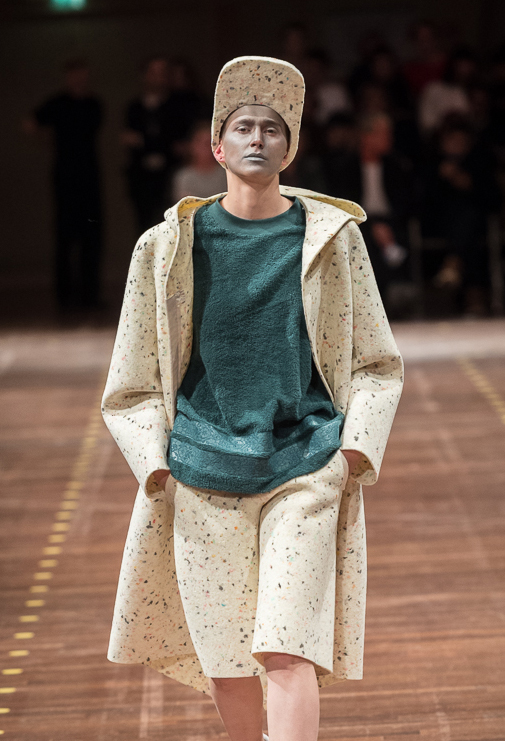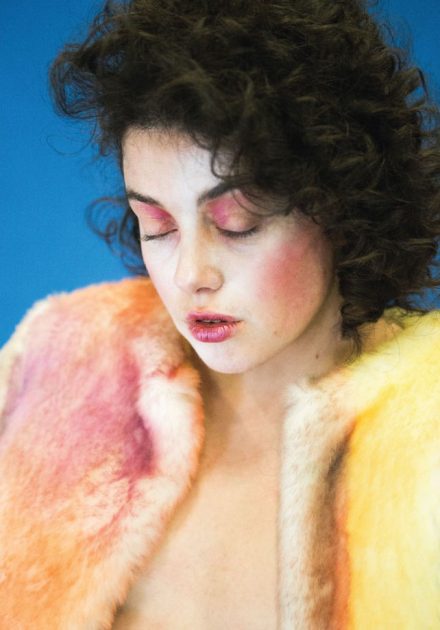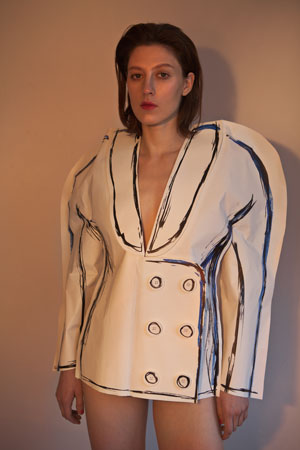On Friday night, UDK’s design department treated Berlin’s fashion partisans to a rousing graduation show. The annual happening, held at Estrel Hotel, saw 14 collections debut on a dynamic square catwalk. Throughout the event, a discreet coolness consisting of deconstructed, often genderless silhouettes and charismatic models with very individual features, ruled the runway. There were tassels, ruffles, sneakers with massive soles in bubble gum colours as well as frilly heels sticking out of tights, printed t-shirts, asymmetric overalls and track suits, clean cut monochrome looks, opulent draperies and a poodle…



On the whole, the show had a strong “Berlin” allure, but didn’t fail to reflect a more international zeitgeist, not to mention the ongoing conversation about diversity and a critical understanding of all things speeding up in the way clothes are produced and then disposed of. In a few cases this was extremely palpable.
Gesine Försterling’s collection “Work”, was inspired by the antithesis between work as a privilege and work as an obligation, clothes as status symbol and clothes as useful support for the body. “Just like the notion of work, clothes stand for maintenance and preservation and at the same time represent a symbol of self-fulfillment,” recalled the designer. In this sense, work clothes are a compelling testimony of the culture-determined changes the work sector is undergoing. Her collection is an eclectic sequence of loose-fit Kimonos and overalls, layered trousers, aprons and vests with decorated fronts – rickrack and chunky embroideries. Business-like elements, such as pinstripes are combined with bulky stained sneakers inspired by manual work attire, which resulted in a strident clash.
Another student, Aïcha Abbadi, decided to focus on the stages defining work, or rather the creative process itself. On the catwalk she shares a six look collection called “Unique Forms of Discarded Ideas”, which referenced Umberto Boccion’s futuristic sculpture “Unique Forms of Continuity in Space”. As stated by the designer, “the work is a visualization of it’s own creation where each silhouette represents a step of the creative process behind fashion design, including all the ideas abandoned in favour of changes and refinement en route and leading to the final product”. On the catwalk the outfits, a patchwork of raw cut cloth and unrefined shapes, look more like human moodboards. Blank dungarees are covered in material samples, loud prints, sketches and oversize pockets which break the familiar margins of the body. Despite their “unfinished” nature, Aicha’s looks make a very statuary and coherent impact.
In addition to a strong conceptual and experimental attitude and the resulting build up garments, the show also held more pragmatic and ready-to-wear oriented designs. Raphael Schall’s collection, for instance, was inspired by Berlin’s concrete yard and hip-hop culture, and made editors gazing longingly for a statement cap they never suspected needing. “This is my House” is an edgy ensemble of basket ball shorts made of down, thick foam sleeves and letter jackets in fresh mint colours. To spice up the experience and highlight the roots of his vision, the young designer also provided a live soundtrack by making an unexpected beat box performance on stage.
Altogether, we were pleased to applaud a show where young designers proved their potential and seriousness without forgetting to smile at the contradictions of society and making a little fun of themselves. It was a show that felt modern, not for the sake of entertainment but rather out of need and desire to provide people with solutions to celebrate their uniqueness!
















